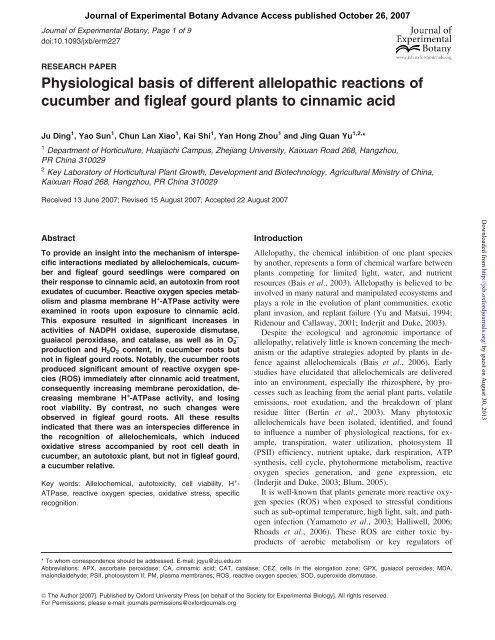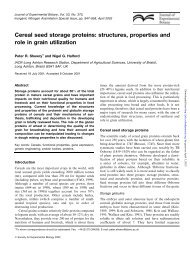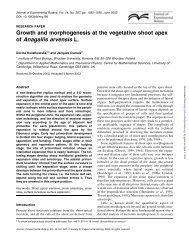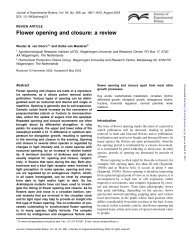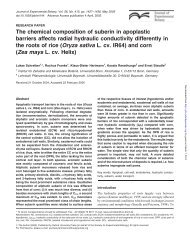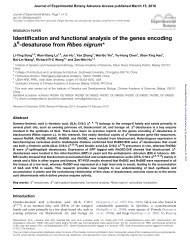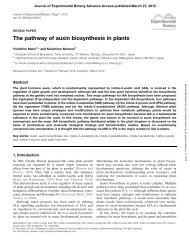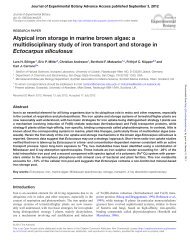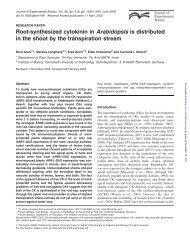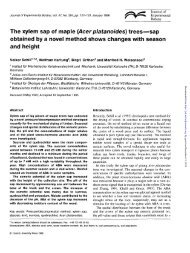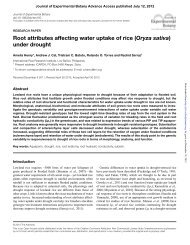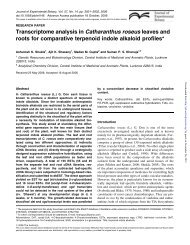Physiological basis of different allelopathic reactions of cucumber ...
Physiological basis of different allelopathic reactions of cucumber ...
Physiological basis of different allelopathic reactions of cucumber ...
You also want an ePaper? Increase the reach of your titles
YUMPU automatically turns print PDFs into web optimized ePapers that Google loves.
Journal <strong>of</strong> Experimental Botany Advance Access published October 26, 2007<br />
Journal <strong>of</strong> Experimental Botany, Page 1 <strong>of</strong> 9<br />
doi:10.1093/jxb/erm227<br />
RESEARCH PAPER<br />
<strong>Physiological</strong> <strong>basis</strong> <strong>of</strong> <strong>different</strong> <strong>allelopathic</strong> <strong>reactions</strong> <strong>of</strong><br />
<strong>cucumber</strong> and figleaf gourd plants to cinnamic acid<br />
Ju Ding 1 , Yao Sun 1 , Chun Lan Xiao 1 , Kai Shi 1 , Yan Hong Zhou 1 and Jing Quan Yu 1,2, *<br />
1 Department <strong>of</strong> Horticulture, Huajiachi Campus, Zhejiang University, Kaixuan Road 268, Hangzhou,<br />
PR China 310029<br />
2 Key Laboratory <strong>of</strong> Horticultural Plant Growth, Development and Biotechnology, Agricultural Ministry <strong>of</strong> China,<br />
Kaixuan Road 268, Hangzhou, PR China 310029<br />
Received 13 June 2007; Revised 15 August 2007; Accepted 22 August 2007<br />
Abstract<br />
To provide an insight into the mechanism <strong>of</strong> interspecific<br />
interactions mediated by allelochemicals, <strong>cucumber</strong><br />
and figleaf gourd seedlings were compared on<br />
their response to cinnamic acid, an autotoxin from root<br />
exudates <strong>of</strong> <strong>cucumber</strong>. Reactive oxygen species metabolism<br />
and plasma membrane H + -ATPase activity were<br />
examined in roots upon exposure to cinnamic acid.<br />
This exposure resulted in significant increases in<br />
activities <strong>of</strong> NADPH oxidase, superoxide dismutase,<br />
guaiacol peroxidase, and catalase, as well as in O 2<br />
2<br />
production and H 2 O 2 content, in <strong>cucumber</strong> roots but<br />
not in figleaf gourd roots. Notably, the <strong>cucumber</strong> roots<br />
produced significant amount <strong>of</strong> reactive oxygen species<br />
(ROS) immediately after cinnamic acid treatment,<br />
consequently increasing membrane peroxidation, decreasing<br />
membrane H + -ATPase activity, and losing<br />
root viability. By contrast, no such changes were<br />
observed in figleaf gourd roots. All these results<br />
indicated that there was an interspecies difference in<br />
the recognition <strong>of</strong> allelochemicals, which induced<br />
oxidative stress accompanied by root cell death in<br />
<strong>cucumber</strong>, an autotoxic plant, but not in figleaf gourd,<br />
a <strong>cucumber</strong> relative.<br />
Key words: Allelochemical, autotoxicity, cell viability, H + -<br />
ATPase, reactive oxygen species, oxidative stress, specific<br />
recognition.<br />
Introduction<br />
Allelopathy, the chemical inhibition <strong>of</strong> one plant species<br />
by another, represents a form <strong>of</strong> chemical warfare between<br />
plants competing for limited light, water, and nutrient<br />
resources (Bais et al., 2003). Allelopathy is believed to be<br />
involved in many natural and manipulated ecosystems and<br />
plays a role in the evolution <strong>of</strong> plant communities, exotic<br />
plant invasion, and replant failure (Yu and Matsui, 1994;<br />
Ridenour and Callaway, 2001; Inderjit and Duke, 2003).<br />
Despite the ecological and agronomic importance <strong>of</strong><br />
allelopathy, relatively little is known concerning the mechanism<br />
or the adaptive strategies adopted by plants in defence<br />
against allelochemicals (Bais et al., 2006). Early<br />
studies have elucidated that allelochemicals are delivered<br />
into an environment, especially the rhizosphere, by processes<br />
such as leaching from the aerial plant parts, volatile<br />
emissions, root exudation, and the breakdown <strong>of</strong> plant<br />
residue litter (Bertin et al., 2003). Many phytotoxic<br />
allelochemicals have been isolated, identified, and found<br />
to influence a number <strong>of</strong> physiological <strong>reactions</strong>, for example,<br />
transpiration, water utilization, photosystem II<br />
(PSII) efficiency, nutrient uptake, dark respiration, ATP<br />
synthesis, cell cycle, phytohormone metabolism, reactive<br />
oxygen species generation, and gene expression, etc<br />
(Inderjit and Duke, 2003; Blum, 2005).<br />
It is well-known that plants generate more reactive oxygen<br />
species (ROS) when exposed to stressful conditions<br />
such as sub-optimal temperature, high light, salt, and pathogen<br />
infection (Yamamoto et al., 2003; Halliwell, 2006;<br />
Rhoads et al., 2006). These ROS are either toxic byproducts<br />
<strong>of</strong> aerobic metabolism or key regulators <strong>of</strong><br />
Downloaded from http://jxb.oxfordjournals.org/ by guest on August 30, 2013<br />
* To whom correspondence should be addressed. E-mail: jqyu@zju.edu.cn<br />
Abbreviations: APX, ascorbate peroxidase; CA, cinnamic acid; CAT, catalase; CEZ, cells in the elongation zone; GPX, guaiacol peroxides; MDA,<br />
malondialdehyde; PSII, photosystem II; PM, plasma membranes; ROS, reactive oxygen species; SOD, superoxide dismutase.<br />
ª The Author [2007]. Published by Oxford University Press [on behalf <strong>of</strong> the Society for Experimental Biology]. All rights reserved.<br />
For Permissions, please e-mail: journals.permissions@oxfordjournals.org
2<strong>of</strong>9<br />
Ding et al.<br />
growth, development, and the defence pathway (Mehdy<br />
et al., 1996; Laloi et al., 2004; Mittler et al., 2004). Toxic<br />
ROS can affect membrane permeability, cause damage to<br />
DNA and protein, induce lipid peroxidation, and ultimately<br />
lead to programmed cell death. Recent findings<br />
about the biochemical and physiological effect <strong>of</strong> natural<br />
phytotoxins, have shed light on the rhizosphere interactions<br />
(Weir et al., 2004). Several studies including our<br />
early studies have shown that allelochemical stress can<br />
cause oxidative damage, as evidenced by enhanced activity<br />
<strong>of</strong> ROS-scavenging enzymes and increased degree <strong>of</strong><br />
membrane lipid peroxidation (Baziramakenga et al., 1995;<br />
Politycka, 1996; Yu et al., 2003; Lara-Nunez et al., 2006;<br />
Ye et al., 2004, 2006). Furthermore, Bais et al. (2003)<br />
found that allelochemicals such as catechin could trigger<br />
a wave <strong>of</strong> ROS, lead to a Ca 2+ signalling cascade, induce<br />
genome-wide changes <strong>of</strong> gene expression, and ultimately<br />
result in the death <strong>of</strong> the root in susceptible species.<br />
Autointoxication is a special kind <strong>of</strong> allelopathy which<br />
occurs within the same plant species. There exist a lot <strong>of</strong><br />
genetic variations in the autotoxic potentials <strong>of</strong> Cucurbitaceous<br />
plants (Yu et al., 2000). Some species such as<br />
<strong>cucumber</strong>, watermelon, and melon show autotoxic potential,<br />
while others do not. Indeed, a difference in autotoxic<br />
potential was also observed among <strong>cucumber</strong> genotypes<br />
(Asao et al., 1998). The poor plant growth in monocropping<br />
<strong>of</strong> <strong>cucumber</strong> or watermelon is supposed to be related<br />
to autointoxication partly arising from root exudates (Yu<br />
et al., 2000). Autotoxins including benzoic acid and<br />
cinnamic acid have been identified from root exudates <strong>of</strong><br />
<strong>cucumber</strong> plants and they had detrimental effects on ion<br />
uptake and enhanced the incidence <strong>of</strong> Fusarium wilt by<br />
triggering oxidative stress in <strong>cucumber</strong> (Yu and Matsui,<br />
1994, 1997; Ye et al., 2004, 2006). Interestingly, root<br />
exudates <strong>of</strong> <strong>cucumber</strong> or watermelon showed high phytotoxicity<br />
to <strong>cucumber</strong> and watermelon themselves, respectively,<br />
but not to other species such as figleaf gourd<br />
(Yu et al., 2000). Apparently, there is an interspecific difference<br />
in the response to phytotoxic constituents in root<br />
exudates as observed in other studies (Weir et al., 2003).<br />
The mechanisms involved, however, have not been extensively<br />
investigated. It is hypothesized that ROS status<br />
is an important mechanism involved in the interspecific<br />
difference in response to allelochemicals. Cinnamic acid is<br />
the principal autotoxin in root exudates <strong>of</strong> <strong>cucumber</strong> identified<br />
(Yu and Matsui, 1994) and the model allelochemicals<br />
used in many studies (Baziramakenga et al., 1995;<br />
Politycka, 1996; Yu and Matsui, 1997; Ye et al., 2004,<br />
2006; Blum, 2005). Accordingly, the effects <strong>of</strong> cinnamic<br />
acid (CA) on growth, ROS generation rate, and ROSscavenging<br />
enzyme activity were investigated in <strong>cucumber</strong><br />
and figleaf gourd seedlings. Meanwhile, ROS generation<br />
and cell viability in roots were also monitored by<br />
cellular approaches that have not been fully employed in<br />
allelopathy study (Bais et al., 2003).<br />
Materials and methods<br />
Growth bioassay<br />
Two species, <strong>cucumber</strong> (Cucumis sativus L. cv. Jinyan No. 4) and<br />
figleaf gourd (Cucurbita ficifolia Bouché), were used. Seeds <strong>of</strong> both<br />
species were directly sown in vermiculite and grown for 7 d in<br />
a non-heated greenhouse at Zhejiang University, China. Average<br />
day/night temperatures were 25/20 °C. Groups <strong>of</strong> seedlings were<br />
then transplanted into a container (40325315 cm) filled with 8.0 l<br />
<strong>of</strong> Enshi nutrient solution (Yu and Matsui, 1997), and maintained at a<br />
relative humidity <strong>of</strong> 95–100%, a photosynthetic photon flux density<br />
(PPFD) <strong>of</strong>500lmol m 2 s 1 , and a temperature <strong>of</strong> 25–30 °C for6<br />
d. When the <strong>cucumber</strong> seedling was at the two-leaf stage, cinnamic<br />
acid (CA) dissolved in ethanol was added into the nutrient solution at<br />
concentrations <strong>of</strong> 0, 0.05, 0.10, 0.15, 0.20, or 0.25 mM. The final<br />
concentration <strong>of</strong> ethanol in each solution including the control was<br />
0.1% (v/v), at which concentration ethanol has a negligible effect on<br />
<strong>cucumber</strong> plants (Yu and Matsui, 1997). Each treatment had eight<br />
plants and was in triplicate. Three days later, plants were harvested,<br />
oven-dried at 80 °C for 3 d and then weighed. Meanwhile, samples<br />
were taken for the determination <strong>of</strong> reactive oxygen species and<br />
associated enzyme activity, lipid peroxidation, as well as NADPH<br />
oxidase activity.<br />
Determination <strong>of</strong> NADPH oxidase activity <strong>of</strong><br />
plasma membranes (PMs)<br />
Root PM was isolated using the two-phase aqueous polymer partition<br />
system as described by Larsson et al. (1987). Briefly, root<br />
samples were homogenized in 4 vols <strong>of</strong> the extraction buffer (50<br />
mM TRIS–HCl, pH 7.5, 0.25 M sucrose, 1 mM AsA, 1 mM EDTA,<br />
0.6% polyvinylpyrrolidone (PVP), and 1 mM PMSF). The homogenate<br />
was filtered through four layers <strong>of</strong> cheesecloth, and the<br />
resulting filtrate was centrifuged at 10 000 g for 15 min. Microsomal<br />
membranes were pelleted from the supernatant by centrifugation at<br />
50 000 g for 30 min. The pellet was suspended in 0.33 M sucrose, 3<br />
mM KCl, and 5 mM potassium phosphate, pH 7.8. The plasma<br />
membrane fraction was isolated by adding the microsomal suspension<br />
to an aqueous two-phase polymer system to give a final<br />
composition <strong>of</strong> 6.2% (w/w) Dextran T500, 6.2% (w/w) PEG 3350,<br />
0.33 M sucrose, 3 mM KCl, and 5 mM potassium phosphate, pH<br />
7.8. Three successive rounds <strong>of</strong> partitioning yielded the final upper<br />
phase. The upper phase produced was diluted 5-fold in TRIS–HCl<br />
dilution buffer (10 mM, pH 7.4) containing 0.25 M sucrose, 1 mM<br />
EDTA, 1 mM dithiothreitol, 1 mM ASC, and 1 mM PMSF. The<br />
fractions were centrifuged at 120 000 g for 30 min. The pellets were<br />
then resuspended in TRIS–HCl dilution buffer and used immediately<br />
for further analysis. All procedures were carried out at 4 °C.<br />
Protein content <strong>of</strong> PM was determined according to the method <strong>of</strong><br />
Bradford (1976) with bovine serum albumin (BSA) as standard. To<br />
determine NADPH oxidation rate, 50 ll <strong>of</strong> the isolated PM vesicles<br />
was added to a reaction mixture consisting <strong>of</strong> 50 mM HEPES–KOH<br />
(pH 7.8), 100 lM EDTA, and 1 lM KCN in a final volume <strong>of</strong> 1 ml<br />
(Pinton et al., 1994). KCN was added to block peroxidase activity.<br />
Reactions were initiated by the addition <strong>of</strong> 100 lM NADPH. The<br />
NADPH oxidation rate was based on a decrease <strong>of</strong> A 340 after<br />
incubation at 30 °C for 5 min.<br />
Antioxidant enzyme activity and reactive oxygen<br />
species determination<br />
Antioxidant enzyme extraction and the activity determination were<br />
carried out as described by Zhou et al. (2004). Generally, each 0.5 g<br />
<strong>of</strong> root material was homogenized in 3 ml <strong>of</strong> 25 mM HEPES<br />
buffer (pH 7.8) containing 0.2 mM EDTA and 2% (w/v) PVP. The<br />
homogenate was centrifuged for 20 min at 12 000 g and the<br />
Downloaded from http://jxb.oxfordjournals.org/ by guest on August 30, 2013
supernatant obtained was used for enzyme analysis. All operations<br />
were carried out at 0–4 °C. An aliquot <strong>of</strong> the extract was used to<br />
determine protein content following Bradford (1976), using BSA as<br />
a standard.<br />
Total superoxide dismutase (SOD, EC 1.15.1.1) activity was<br />
measured by the photochemical method as described by Giannopolitis<br />
and Ries (1977). One unit <strong>of</strong> SOD activity was defined as the<br />
amount <strong>of</strong> enzyme required to cause a 50% inhibition <strong>of</strong> the rate <strong>of</strong><br />
q-nitroblue tetrazolium chloride reduction at 560 nm. The activity<br />
<strong>of</strong> guaiacol peroxidase (GPX, EC 1.11.1.7) was assayed according<br />
to the method <strong>of</strong> Cakmak and Marschner (1992). Ascorbate peroxidase<br />
(APX, EC 1.11.1.11) activity was measured according to<br />
Nakano and Asada (1981) by monitoring the rate <strong>of</strong> ascorbate oxidation<br />
at 290 nm (E¼2.8 mM cm 1 ). Catalase (CAT, EC 1.16.1.6)<br />
activity was assayed in a reaction mixture containing 25 mM phosphate<br />
buffer (pH 7.0), 10 mM H 2 O 2 , and the enzyme. The<br />
decomposition <strong>of</strong> H 2 O 2 was followed at 240 nm (E¼39.4 mM<br />
cm 1 ) (Cakmak and Marschner, 1992). Since protein content is<br />
comparable between the samples <strong>of</strong> both species, the same aliquot<br />
<strong>of</strong> the extract was used for the enzyme assay.<br />
<br />
O 2 was measured as described by Elstner and Heupel (1976) by<br />
monitoring the nitrite formation from hydroxylamine in the presence<br />
<strong>of</strong> O 2 . The content <strong>of</strong> H 2 O 2 was measured by monitoring the<br />
<br />
A 410 <strong>of</strong> titanium-peroxide complex following the method described<br />
by MacNevin and Uron (1953).<br />
Determination <strong>of</strong> lipid peroxidation and plasma membrane<br />
H + -ATPase activity measurement<br />
For the measurement <strong>of</strong> lipid peroxidation in roots, the thiobarbituric<br />
acid (TBA) test was used, which determines malondialdehyde<br />
(MDA) as an end-product <strong>of</strong> lipid peroxidation (Zhou et al., 2004).<br />
The plasma membrane (PM)-enriched and tonoplast (TP)-enriched<br />
vesicles were prepared as described by Kasamo (1986) with some<br />
modifications. In brief, roots were cut into pieces and immediately<br />
homogenized in isolation medium (1/2, w/v) containing 300 mM<br />
sucrose, 5 mM EDTA, 0.5 mM EGTA, 2 mM 1,4-dithiothreitol<br />
(DTT), 1.5% (w/v) PVP, 60 mM HEPES–TRIS (pH 7.5). The<br />
homogenate was filtered through four layers <strong>of</strong> cheesecloth and<br />
centrifuged at 8 000 g for 20 min. The supernatant was loaded on<br />
top <strong>of</strong> a gradient consisting <strong>of</strong> 45/33/15% sucrose and centrifuged at<br />
80 000 g for 150 min. The TP-enriched membrane fraction and the<br />
PM-enriched membrane fraction were collected from the 15/33%<br />
and 33/45% sucrose interfaces, diluted in three times by volume <strong>of</strong><br />
a buffer containing 20 mM HEPES–TRIS (pH 7.5), 0.5 mM EDTA,<br />
0.5 mM EGTA, and then centrifuged at 10 000 g for 60 min. The<br />
pellets were collected and suspended in 0.5 ml <strong>of</strong> solution<br />
containing 20 mM HEPES–TRIS (pH 7.5), 300 mM sucrose, 0.5<br />
mM EGTA, 3 mM MgCl 2 .6H 2 O. The preparation procedures were<br />
carried out at 4 °C. The activity <strong>of</strong> H + -ATPase was then determined<br />
by measuring the release <strong>of</strong> Pi according to Ohinishi et al. (1975).<br />
Different response to allelochemical between species<br />
(Diagnostic Instruments, Sterling Heights, MI) with 488 nm excitation,<br />
488 nm dichroic and 510–560 nm emission, respectively.<br />
FDA fluorescence decreases as the dye leaks from the dead cells.<br />
CM-H2DCFDA fluorescence increases as the dye is oxidized by<br />
ROS to dichlor<strong>of</strong>luorescein (DCF).<br />
Statistical methods<br />
Measurements were performed randomly using three replicates except<br />
that the biomass assay was carried out using four replicates.<br />
SAS 8.0 (SAS Institute, Cary, North Carolina) for windows was<br />
used for statistical analysis. The data were analysed with a one-way<br />
analysis <strong>of</strong> variance and differences between treatments were separated<br />
by the Tukey’s HSD test at the P
4<strong>of</strong>9<br />
In the absence <strong>of</strong> CA, there was no significant difference<br />
in the activity <strong>of</strong> root NADPH oxidase between <strong>cucumber</strong><br />
and figleaf gourd. Exposure to CA, however, induced an<br />
increase (by 84.2%) <strong>of</strong> NADPH oxidase activity in <strong>cucumber</strong><br />
roots. By contrast, such an increase was not<br />
found in roots <strong>of</strong> figleaf gourd at the same CA concentration<br />
(Fig. 2).<br />
NADPH oxidase activity<br />
(nmol mg -1 protein min -1 )<br />
Ding et al.<br />
5<br />
4<br />
3<br />
2<br />
1<br />
0<br />
b<br />
a<br />
Cucumber<br />
a<br />
a<br />
Figleaf gourd<br />
Fig. 2. Effects <strong>of</strong> cinnamic acid (CA) on the NADPH oxidase activity<br />
in roots <strong>of</strong> <strong>cucumber</strong> and figleaf gourd. Plant roots were sampled 3<br />
d after exposure to 0 mM (white bars) and 0.25 mM CA (dark bars).<br />
Data are the means <strong>of</strong> three replicates with standard errors shown by<br />
vertical bars. Bars sharing the same letters are not significantly <strong>different</strong><br />
within the species (P
Different response to allelochemical between species<br />
5<strong>of</strong>9<br />
2.0<br />
140<br />
O .-<br />
2 production rate<br />
(nmol mg -1 FW min -1 )<br />
1.5<br />
1.0<br />
0.5<br />
0.0<br />
∗<br />
∗<br />
∗<br />
∗<br />
∗<br />
(a)<br />
(b)<br />
0.00 0.05 0.10 0.15 0.20 0.25 0.00 0.05 0.10 0.15 0.20 0.25<br />
Cinnamic acid (mM)<br />
120<br />
100<br />
80<br />
60<br />
40<br />
H2 O 2 content<br />
(nmol g -1 FW)<br />
<br />
Fig. 4. Effects <strong>of</strong> cinnamic acid (CA) at <strong>different</strong> concentrations on the O 2 production rate and H 2 O 2 accumulation in roots <strong>of</strong> <strong>cucumber</strong> (open<br />
circles) and figleaf gourd (closed circles) plants 3 d after treatment. Data are the means <strong>of</strong> three replicates with standard errors shown by vertical bars.<br />
Asterisks indicate a significant difference between the control and the CA treatment within the species (P
6<strong>of</strong>9<br />
PM -H + -ATPase activity<br />
(µmolPi mg -1 protein h -1 )<br />
TP-H + -ATPase activity<br />
(µmolPi mg -1 protein h -1 )<br />
Ding et al.<br />
16<br />
12<br />
8<br />
4<br />
0<br />
1.0<br />
0.8<br />
0.6<br />
0.4<br />
(a)<br />
(b)<br />
0.00 0.05 0.10 0.15 0.20 0.25<br />
Cinnamic acid (mM)<br />
Fig. 6. Effects <strong>of</strong> cinnamic acid (CA) at <strong>different</strong> concentrations on<br />
activities <strong>of</strong> (a) plasma membrane (PM) H + -ATPase and (b) tonoplast<br />
(TP) H + -ATPase in <strong>cucumber</strong> (open circles) and figleaf gourd (closed<br />
circles) roots. Samples were taken 3 d after CA treatment. Data are the<br />
means <strong>of</strong> three replicates with standard errors shown by vertical bars.<br />
Asterisks indicate a significant difference between the control and the<br />
CA treatment within the species (P
Different response to allelochemical between species<br />
7<strong>of</strong>9<br />
Fig. 8. Changes in root cell viability in 5-d-old seedlings <strong>of</strong> <strong>cucumber</strong> and figleaf gourd after exposure to cinnamic acid (CA, 0.25 mM). (a),<br />
<strong>cucumber</strong>; (b), figleaf gourd; (c), <strong>cucumber</strong> at <strong>different</strong> times after CA treatment. Figures represent minutes after treatment. Note: (i) Green and red<br />
colours indicate live and dead cells, respectively, while the yellow colour indicates a dying cell in Fig. 8a and b. (ii) FDA fluorescence decreases as<br />
the dye leaks from dead cell and high green fluorescence indicates high cell viability in Fig. 8c.<br />
<strong>cucumber</strong> roots, but not in figleaf gourd roots (Figs 4, 7).<br />
This large difference in ROS generation could be an important<br />
factor that regulates the occurrence or absence<br />
<strong>of</strong> phytotoxicity in <strong>cucumber</strong> and figleaf gourd, respectively.<br />
Although evidence about allelochemical-induced<br />
oxidative stress together with increased activity <strong>of</strong><br />
antioxidant enzymes is emerging (Simard, 1995; Politycka,<br />
1996; Herrig et al., 2002; Baziramakenga et al.,<br />
1995; Yu et al., 2002; Ye et al., 2006), however, little<br />
information is available about the mechanisms by which<br />
allelochemicals induce ROS formation. Many studies have<br />
shown that increased plasma membrane NAD(P)H oxidase<br />
activity was associated with increased O 2 and H 2 O 2<br />
<br />
production following biotic and abiotic stresses (Keller<br />
et al., 1999; Forman et al., 2002; Lara-Nunez et al.,<br />
2006). Here CA induced an increased activity <strong>of</strong> NADPH<br />
oxidase in <strong>cucumber</strong> roots, but little in figleaf gourd roots<br />
(Fig. 2). Accordingly, it is clear that CA could trigger<br />
ROS generation by root cell membranes in <strong>cucumber</strong> but<br />
not in figleaf gourd. In agreement with the increase <strong>of</strong><br />
<br />
NADPH oxidase activity (Fig. 2), both O 2 production<br />
and H 2 O 2 accumulation increased with the CA concentration<br />
in <strong>cucumber</strong> roots but not in figleaf gourd (Fig. 4).<br />
Accordingly, it seems likely that NADPH oxidase is one<br />
<strong>of</strong> the generation sites for ROS in <strong>cucumber</strong> roots.<br />
Plants possess both enzymatic (superoxide dismutase,<br />
various peroxidases, catalase, etc.) and non-enzymatic<br />
defence systems for the detoxification <strong>of</strong> various types <strong>of</strong><br />
ROS (e.g. peroxides, superoxides) (Laloi et al., 2004).<br />
Increases <strong>of</strong> ROS-scavenging enzyme activities have been<br />
observed in <strong>cucumber</strong> roots after exposure to allelochemicals<br />
in previous studies (Baziramakenga et al., 1995;<br />
Politycka, 1996; Yu et al., 2002; Ye et al., 2006). In this<br />
study, figleaf gourd roots maintained higher activity <strong>of</strong><br />
SOD, GPX, and APX than <strong>cucumber</strong> roots in the absence<br />
<strong>of</strong> CA. Importantly, increases <strong>of</strong> these enzyme activities<br />
were induced by CA only in <strong>cucumber</strong> roots, but not in<br />
figleaf gourd (Fig. 3). This discrepancy is apparently<br />
related to the difference in NADPH oxidase activity and<br />
the intrinsic capacity for ROS-scavenging between the<br />
two species. Cucumber roots exhibited higher NADPH<br />
<br />
oxidase activity, leading to higher O 2 production and<br />
ROS-scavenging activity (SOD, GPX, APX, and CAT).<br />
The insensitive response <strong>of</strong> NADPH oxidase to change <strong>of</strong><br />
CA concentration in figleaf gourd suggests that CA could<br />
induce little change in ROS generation and ROS-scavenging<br />
activity as shown in Fig. 3 and Fig. 4.<br />
Although there was an increased level <strong>of</strong> antioxidants in<br />
roots after exposure to allelochemical stress, oxidative<br />
stress still occurred as described in an earlier study (Figs<br />
7, 8; Yu et al., 2002). In Arabidopsis, (-)-catechin triggered<br />
a wave <strong>of</strong> ROS initiated in the roots, which led to<br />
aCa 2+ signalling cascade triggering genome-wide changes<br />
in gene expression and, ultimately, death <strong>of</strong> the roots<br />
(Bais et al., 2003; Weir et al., 2006). Consistently,<br />
changes <strong>of</strong> ROS and cell viability occurred coincidently<br />
in <strong>cucumber</strong> roots in the experiment (Figs 7, 8). It is well<br />
known that ROS accumulation causes damage to DNA<br />
and proteins, induces lipid peroxidation, and ultimately<br />
leads to programmed cell death. The finding that CA<br />
treatment resulted in significant decrease <strong>of</strong> PM-H + -<br />
ATPase and TP-H + -ATPase activities in <strong>cucumber</strong> roots,<br />
but not in figleaf roots (Fig. 6), also supports the hypothesis<br />
that allelochemical-induced ROS accumulation<br />
is extremely harmful for the membrane protein (Friebe<br />
et al., 1997; Hejl and Koster, 2004; Ye et al., 2006). In<br />
agreement with Bais et al. (2003), it was found that the<br />
species-specific ROS accumulation patterns reflected the<br />
differences in other physiological parameters such as<br />
H + -ATPase, root cell viability, and root growth. Moreover,<br />
it was found that cells in the elongation zone (CEZ) lost<br />
their viability more significantly than cells in apex (Fig. 8).<br />
ROS formation was more significant in CEZ than in the<br />
root apex (Fig. 7). Accordingly, ROS-induced cell death<br />
occurred in <strong>cucumber</strong> roots, but not in figleaf gourd roots.<br />
Interestingly, Bais et al. (2003) found that exotic plants<br />
show <strong>allelopathic</strong> potential by triggering ROS accumulation<br />
and programmed cell death in receiver plant species but not<br />
in donor plant species. This may be one <strong>of</strong> the fundamental<br />
differences between allelopathy and autotoxicity.<br />
In summary, this study has demonstrated that one<br />
autotoxic plant experienced an increased ROS generation<br />
and accumulation in roots, leading to increased membrane<br />
peroxidation, decreased H + -ATPase activity, and finally<br />
loss <strong>of</strong> root viability while another species was largely<br />
insensitive to this chemical with little change in ROS<br />
Downloaded from http://jxb.oxfordjournals.org/ by guest on August 30, 2013
8<strong>of</strong>9<br />
Ding et al.<br />
metabolism. Further study on allelochemical uptake,<br />
compartmentalization, and detoxification is necessary to<br />
elucidate the mechanism involved in this specific recognition<br />
ability.<br />
Acknowledgements<br />
We are grateful to JM Vivanco and H Ye for their critical reading<br />
and revision <strong>of</strong> the manuscript. This work was supported by the<br />
National Natural Science Foundation <strong>of</strong> China (30235029;<br />
300070522) and the National Outstanding Youth Foundation<br />
(30230250).<br />
References<br />
An M, Pratley JE, Haig T. 2001a. Phytotoxicity <strong>of</strong> vulpia<br />
residues. III. Biological activity <strong>of</strong> identified alleochemicals from<br />
Vulpia myuros. Journal <strong>of</strong> Chemical Ecology 27, 381–392.<br />
An M, Pratley JE, Haig T. 2001b. Phytotoxicity <strong>of</strong> vulpia<br />
residues. IV. Dynamics <strong>of</strong> allelochemicals during decomposition<br />
<strong>of</strong> vulpia residues and their corresponding phytotoxicity. Journal<br />
<strong>of</strong> Chemical Ecology 27, 395–409.<br />
Asao T, Umeyama M, Ohta K, Hosoki T, Ito N, Ueda H. 1998.<br />
Decrease <strong>of</strong> yield <strong>of</strong> <strong>cucumber</strong> by non-renewal <strong>of</strong> the nutrient<br />
hydroponic solution and its reversal by supplementation <strong>of</strong><br />
activated charcoal. Journal <strong>of</strong> the Japanese Society for Horticultural<br />
Science 67, 99–105.<br />
Bais HP, Vepachedu R, Gilroy S, Callaway RM, Vivanco JM.<br />
2003. Allelopathy and exotic plant invasion: from molecules and<br />
genes to species interactions. Science 301, 1377–1380.<br />
Bais HP, Weir TL, Perry LG, Gilroy S, Vivanco JM. 2006. The<br />
role <strong>of</strong> root exudates in rhizosphere interactions with plants and<br />
other organisms. Annual Review <strong>of</strong> Plant Biology 57, 233–266.<br />
Baziramakenga R, Leroux GD, Simard RR. 1995. Effects <strong>of</strong><br />
benzoic and cinnamic acids on membrane permeability <strong>of</strong><br />
soybean roots. Journal <strong>of</strong> Chemical Ecology 21, 1271–1285.<br />
Bertin C, Yang XH, Weston LA. 2003. The role <strong>of</strong> root exudates<br />
and allelochemicals in the rhizosphere. Plant and Soil 256,<br />
67–83.<br />
Blum U. 2005. Relationships between phenolic acid concentrations,<br />
transpiration, water utilization, leaf area expansion, and uptake <strong>of</strong><br />
phenolic acids: nutrient culture studies. Journal <strong>of</strong> Chemical<br />
Ecology 31, 1907–1932.<br />
Bradford MM. 1976. A rapid and sensitive method for the<br />
quantitation <strong>of</strong> microgram quantities <strong>of</strong> protein utilizing the<br />
principle <strong>of</strong> protein–dye binding. Analytical Biochemistry 72,<br />
248–254.<br />
Cakmak I, Marschner H. 1992. Magnesium deficiency and high<br />
light intensity enhance activities <strong>of</strong> superoxide dismutase ascorbate<br />
peroxidase, and glutathione reductase in bean leaves. Plant<br />
Physiology 98, 1222–1227.<br />
Canals RM, Emeterio LS, Peralta J. 2005. Autotoxicity in<br />
Lolium rigidum: analysing the role <strong>of</strong> chemically mediated<br />
interactions in annual plant populations. Journal <strong>of</strong> Theoretical<br />
Biology 235, 402–407.<br />
Elstner EF, Heupel A. 1976. Inhibition <strong>of</strong> nitrite formation from<br />
hydroxylammoniumchloride: a simple assay for superoxide<br />
dismutase. Analytical Biochemistry 70, 616–620.<br />
Ezaki B, Gardner RC, Ezaki Y, Matsumoto H. 2000. Expression<br />
<strong>of</strong> aluminum-induced genes in transgenic Arabidopsis plants can<br />
ameliorate aluminum stress and/or oxidative stress. Plant Physiology<br />
122, 657–665.<br />
Forman HJ, Torres M, Fukuto J. 2002. Redox signaling.<br />
Molecular and Cellular Biochemistry 234, 49–62.<br />
Friebe A, Roth U, Kuck P. 1997. Effects <strong>of</strong> 2,4-dihydroxy-1,4-<br />
benzoxazin-3-ones on the activity <strong>of</strong> plasma membrane H + -<br />
ATPase. Phytochemistry 44, 979–983.<br />
Fryer MJ, Oxborough K, Mullineaux PM, Baker NR. 2002.<br />
Imaging <strong>of</strong> photo-oxidative stress responses in leaves. Journal <strong>of</strong><br />
Experimental Botany 53, 1249–1254.<br />
Giannopolitis N, Ries SK. 1977. Superoxide dismutase. I.<br />
Occurrence in higher plants. Plant Physiology 59, 309–314.<br />
Halliwell B. 2006. Reactive species and antioxidants. Redox<br />
biology is a fundamental theme <strong>of</strong> aerobic life. Plant Physiology<br />
141, 312–322.<br />
Hejl AM, Koster KL. 2004. The allelochemical sorgoleone<br />
inhibits root H + -ATPase and water uptake. Journal <strong>of</strong> Chemical<br />
Ecology 30, 2181–2191.<br />
Herrig V, De Lourdes M, Ferrarese MDL, Suzuki LS,<br />
Rodrigues JD, Ferrarese O. 2002. Peroxidase and phenylalanine<br />
ammonia-lyase activities, phenolic acid contents, and<br />
allelochemicals-inihibited root growth <strong>of</strong> soybean. Biological<br />
Research 35, 59–66.<br />
Inderjit, Duke SO. 2003. Ecophysiological aspect <strong>of</strong> allelopathy.<br />
Planta 217, 529–539.<br />
Kasamo K. 1986. Comparison <strong>of</strong> plasma membrane and tonoplast<br />
H + -translocating ATPase in Phaseolus mungo L. Plant Cell<br />
Physiology 27, 49–59.<br />
Keller T, Damude HG, Werner D, Doerner P, Dixon RA,<br />
Lamb C. 1998. A plant homolog <strong>of</strong> the neutrophil NADPH<br />
oxidase gp91(phox) subunit gene encodes a plasma membrane<br />
protein with Ca 2+ binding motifs. The Plant Cell 10, 255–266.<br />
Lara-Nunez A, Romero-Romero T, Ventura JL, Blancas V,<br />
Anaya AL, Cruz-Ortega R. 2006. Allelochemical stress causes<br />
inhibition <strong>of</strong> growth and oxidative damage in Lycopersicon<br />
esculentum Mill. Plant, Cell and Environment 29, 2009–2016.<br />
Larsson C, Widell S, Kjellbom P. 1987. Preparation <strong>of</strong> high-purity<br />
plasma membranes. Methods in Enzymology 148, 558–568.<br />
Laloi C, Apel K, Danon A. 2004. Reactive oxygen signalling: the<br />
latest news. Current Opinion in Plant Biology 7, 323–328.<br />
MacNevin WM, Uron PF. 1953. Separation <strong>of</strong> hydrogen peroxide<br />
from organic hydroperoxide. Analytical Biochemistry 25,<br />
1760–1761.<br />
Mehdy MG, Sharma YK, Sathasivan K, Bays NW. 1996. The<br />
role <strong>of</strong> activated oxygen species in plant disease resistance.<br />
Physiologia Plantarum 98, 365–374.<br />
Mittler R, Vanderauwere S, Gollery M, Breusegem FV. 2004.<br />
Reactive oxygen gene network <strong>of</strong> plants. Trends in Plant Science<br />
9, 490–498.<br />
Nakano Y, Asada K. 1981. Hydrogen peroxide is scavenged by<br />
ascorbate specific peroxidase in spinach chloroplasts. Plant Cell<br />
Physiology 22, 679–690.<br />
Ohinishi T, Gall RS, Mayer ML. 1975. An improved assay <strong>of</strong><br />
inorganic phosphate in the presence <strong>of</strong> extralabile phosphate<br />
compounds: application to the ATPase assay in the presence <strong>of</strong><br />
phosphocreatine. Analytical Biochemistry 69, 261–267.<br />
Pinton R, Cakmak I, Marschner H. 1994. Zinc deficiency<br />
enhanced NAD(P)H-dependent superoxider radical production in<br />
plasma membrane vesicles isolated from roots <strong>of</strong> bean plants.<br />
Journal <strong>of</strong> Experimental. Botany 45, 45–50.<br />
Politycka B. 1996. Peroxidase activity and lipid peroxidation in<br />
roots <strong>of</strong> <strong>cucumber</strong> seedlings influenced by derivatives <strong>of</strong> cinnamic<br />
and benzoic acids. Acta Physiologiae Plantarum 18, 365–370.<br />
Rhoads DM, Umbach AL, Subbaiah CC, Siedow JN. 2006.<br />
Mitochondrial reactive oxygen species. Contribution to oxidative<br />
stress and interorganellar signaling. Plant Physiology 141,<br />
357–366.<br />
Downloaded from http://jxb.oxfordjournals.org/ by guest on August 30, 2013
Ridenour WM, Callaway RM. 2001. The relative importance <strong>of</strong><br />
allelopathy in interference: the effects <strong>of</strong> an invasive weed on<br />
a native bunchgrass. Oecologia 126, 444–450.<br />
Tsuchiya D. 1990. Problems on allelopathy in vegetable cropping.<br />
Agriculture and Horticulture 65, 9–16(in Japanese).<br />
Weir TL, Park SW, Vivanco JM. 2004. Biochemical and<br />
physiological mechanisms mediated by allelochemicals. Current<br />
Opinion in Plant Biology 7, 472–479.<br />
Weir TL, Bais HP, Stull VJ, Callaway RM, Thelen GC,<br />
Ridenour WM, Bhamidi S, Stermitz FR, Vivanco JM. 2006.<br />
Oxalate contributes to the resistance <strong>of</strong> Gaillardia grandiflora<br />
and Lupinus sericeas to a phytotoxin produced by Centaurea<br />
maculosa. Planta 223, 785–795.<br />
Weir TL, Bais HP, Vivanco JM. 2003. Intraspecific and interspecific<br />
interactions mediated by a phytotoxin, (-)-catechin,<br />
secreted by the roots <strong>of</strong> Centaurea maculosa (spotted knapweed).<br />
Journal <strong>of</strong> Chemical Ecology 29, 2397–2412.<br />
Yamamoto Y, Kobayashi Y, Devi SR, Rikiishi S, Matsumono H.<br />
2003. Oxidative stress triggered by aluminum in plant roots.<br />
Plant and Soil 255, 239–243.<br />
Ye SF, Zhou YH, Sun Y, Zou LY, Yu JQ. 2006. Cinnamic acid<br />
causes oxidative stress in <strong>cucumber</strong> roots, and promotes incidence<br />
Different response to allelochemical between species<br />
9<strong>of</strong>9<br />
<strong>of</strong> Fusarium wilt. Environmental and Experimental Botany 56,<br />
255–262.<br />
Ye SF, Yu JQ, Peng YH, Zheng JH, Zou LY. 2004. Incidence<br />
<strong>of</strong> Fusarium wilt in Cucumis sativus L. is promoted by cinnamic<br />
acid, an autotoxin in root exudates. Plant and Soil 263,<br />
143–150.<br />
Yu JQ, Matsui Y. 1994. Phytotoxic substances in the root exudates<br />
<strong>of</strong> Cucumis sativus L. Journal <strong>of</strong> Chemical Ecology 20, 21–31.<br />
Yu JQ, Matsui Y. 1997. Effects <strong>of</strong> root exudates <strong>of</strong> <strong>cucumber</strong><br />
(Cucumis sativus) and allelochemicals on uptake by <strong>cucumber</strong><br />
seedlings. Journal <strong>of</strong> Chemical Ecology 23, 817–827.<br />
Yu JQ, Shou SY, Qian YR, Hu WH. 2000. Autotoxic potential in<br />
cucurbit crops. Plant and Soil 223, 147–151.<br />
Yu JQ, Ye SF, Zhang MF, Hu WH. 2003. Effects <strong>of</strong> root<br />
exudates, aqueous root extracts <strong>of</strong> <strong>cucumber</strong> (Cucumis sativus L.)<br />
and allelochemicals on photosynthesis and antioxidant enzymes<br />
in <strong>cucumber</strong>. Biochemical and Systematics Ecology 31, 129–139.<br />
Zhou YH, Yu JQ, Huang LF, Nogues S. 2004. The relationship<br />
between CO 2 assimilation, photosynthetic electron transport, and<br />
water–water cycle in chill-exposed <strong>cucumber</strong> leaves under low<br />
light and subsequent recovery. Plant, Cell and Environment 27,<br />
1503–1514.<br />
Downloaded from http://jxb.oxfordjournals.org/ by guest on August 30, 2013


